Blog Post #1——Web Learning Tools
In this age of technology, people have way many resources to gain knowledge than in the past. In the ebook, “Teaching Online: A Guide to Theory, Research, and Practice”, which was written by Claire Major, She mentioned couple web learning tools that some of them I have never heard before. Also, she evaluates them by courses’ five classifications, which are enrollment, amount, timing, platform, and pathway. It makes me curious about how these tools make people learn what they want more convenient and efficient. Here I’m going to choose two types of learning tools that I’m familiar with.
Moodle
Moodle system is used by instructor Lisa Lane in the ebook. She mainly used it for sending instant messages, course information, videos, and answering questions. “Students comment on how much they enjoy the opportunity to research their own interests and shape their own interpretations and themes” (Major, 2015, p.90). It reminds me that when I was at Royal Roads University, my teachers all used moodle as a learning tool for us. They posted every class materials, feedbacks, announcements on it, and students can get notifications immediately. Also, students can use it to book study rooms, sign up activities, or share their blogs. Moodle makes every student and teacher connect with each other, and make the whole campus as a small, communicative community. A good learning tool not only can teach people new knowledge but also need to inspire people’s motivations to let them have interests in learning.
TED
TED is a website that mainly posts speeches on it. You can choose the talks’ topics that you are interested in, for example, technology, social change, self-improvement…After you choose it, it will recommend related topics to your account. Speakers are from all over the world with different positions. TED’s slogan “ideas worth spreading” shows its purpose. I have many friends using TED as a tool to learn English, and also to open up their thoughts and enrich the knowledge. They comment on how much they get inspired and improved from those talks. TED is not that kind of tool that tightly connects students and teachers, but it’s a useful learning resource that can amplify ideas that you are interested in or curious about.
To sum up, I think Moodle and TED is a good combination for start-up learners. Like I said, a good learning tool not only can bring knowledge to people but also, more importantly, it can create a positive learning environment and motivate people’s learning interests. The one you like and would like to stick with it, then that is the one suitable for you.
Reference:
Major, C. H. (2015). Teaching online: A guide to theory, research, and practice. Baltimore, Maryland: Johns Hopkins University Press.
Blog Post 2——Our Online Information Are All In Control
What I have to say first is that some activities I’ve done before writing this blog shocked me out.
First is about the website https://clickclickclick.click. It’s my first time to take a look at this kind of website. It can track all my activities, like my computer information, the number of websites that I opened before, when and how long it takes me to click a button, etc. You can see as my screenshots showed.

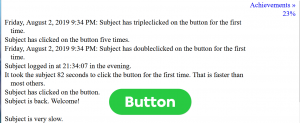
I’m the kind of person that is really careful about my personal information. And I understand that actually, the website and government are monitoring our activities all the time. However, I never realized before it can be that accurate and intelligent. Also, this website uses an anthropomorphic voice to represent its “thoughts”. It makes me feels that this website is actually talking to me and trying to analyze me.
Second is about lightbeam from Firefox. I can see who is tracking me from the web, but the number of trackers is way larger than I think. I downloaded Firefox for the first time, and only opened UVic website and some articles I need to read for homework. Eight websites were opened in total, but in fact, there were 36 sites tacking me. I don’t even know what websites are they.
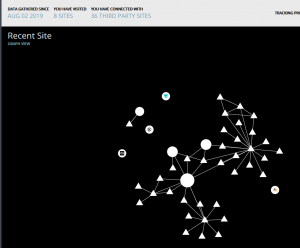
The third one is google account setting. I never click that button before, and when I followed the instructions, I’m really surprised about how Google can get all of my personal information, locations, and preferences. So I paused all functions they might use to track me to see how will it influence my use of google in the future.
To satisfy my curiosity, I choose TED this learning tool to see how it protect users’ information. .TED is a website for everyone to gain knowledge from its speech. I read their terms of service at https://www.ted.com/about/our-organization/our-policies-terms/privacy-policy#h2–how-we-use-your-data. And attached is a screenshot of their parts of the privacy policy.
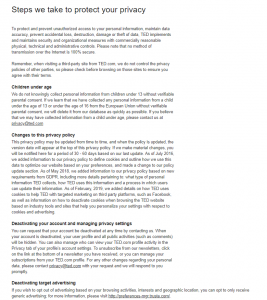
Seems like TED really cares about its users’ information, and trying to protect it well. However, it still has some loopholes according to their words. Just like Jesse said, “What we see there is a blur of words and phrases separated by commas, of which ‘royalty-free, perpetual, world-wide, irrevocable’ are but a scary few. The rat-a-tat-tat of nouns, verbs, and adjectives is so bewildering that almost anyone would blindly click ‘agree’ just to avoid the deluge of legalese. But these words are serious and their ramifications pedagogical”(Jesse, 2018). When we sign up for a website, it always pops up terms of service for us to accept. And mostly have thousands of words. Of course mainly people do not have time to read it carefully, so they just click “accept” in order to continue that website. So companies then use these mental states to pass the buck.
By going through those activities, I understand that although we are all tracked by websites surrounding us, we still need to have the awareness to protect our information. Now is better than never.
Reference:
Morris, S. M., & Stommel, J. (2018). A Guide for Resisting Edtech: The Case Against Turnitin. An Urgency of Teachers. Hybrid Pedagogy Inc. https://criticaldigitalpedagogy.pressbooks.com/chapter/a-guide-for-resisting-edtech-the-case-against-turnitin/
Building Communities by Using Social Media
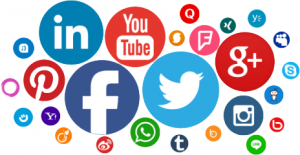
The Internet has been bringing us a lot of conveniences. One of the most intuitive is its ability to deliver real-time data. This has also contributed to the progress of social media, from paper newspapers to online news, from letter exchanges to video phone calls. Through social media, people can make more friends, learn more skills and learn global news. “Our technologies now enable our communities to extend beyond the limitations of our physical beings and thus span the boundaries of time and place” (Major,2015, p.228). This has created online communities.
I divided online communities into three categories. The first is the information-sharing community, the second is the entertainment community, and the third is the education community. Examples of the first type are Google, the New York Times, BBC News… People can search for information or news they want from this community, and they can also create and share their personal information feed.

As for the second type, Facebook, Instagram, Tinder, Tik Tok are popular example applications. People use this kind of social media to kill their time. Users’ interests can be singing, dancing, racing, dating, hiking… And people with the same interest form their communities and share their information. For my EDCI group, we use Wechat as the main tool to communicate with each other. It can simply send text, use video call, and also share your excellent moments in your daily life.
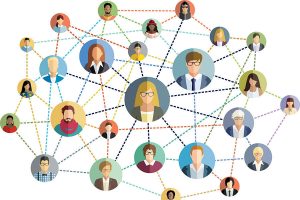
The third type is for education, it’s also the status we are currently experiencing. There are many applications and websites for us to learn, Youtube and Ted Talk are good examples. When I was studying at Royal Roads University, my teacher asked the class to watch her online teaching videos and let us comment on it. It’s a good way to connect the relationship between teacher and students, and it also makes students get familiar with each other.
References:
Major, C. H. (2015). Teaching online: A guide to theory, research, and practice. Baltimore, Maryland: Johns Hopkins University Press.
https://www.waistedefforts.com/index/2018/2/11/the-social-media-jungle
https://www.thebodypro.com/article/popart-study-community-based-services-reduce-hiv
https://www.digitaltrends.com/mobile/best-news-apps/
Blog #4——Open Educational Resources
“Ultimately, I want education to make space for students to be creators of knowledge not just consumers of it ” (Stommel, 2018). As a student at UVic, I need to pay around $500 per semester for textbooks and some online learning tools. Paying around $300 if I am lucky enough to find second-hand textbooks. Some teachers even make new textbooks and learning applications mandatory, students do not have a choice to skip the payments if they have to take those kinds of courses.
It makes me consider a question, is that really what educators and educatees what to impart and gain knowledge?
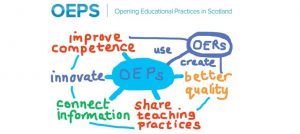
I don’t know if teachers can get commissions from textbook companies when students buy textbooks they required. However, this happened in other countries, like teachers write their own books, and required students to buy a brand new one, even they do not use the textbook as the main materials for teaching. It surely increases those teachers’ income, but it makes students spend money on things they don’t really need, and it twists the purpose of teaching. As a Chinese saying, “Being an educator is a respectable position. As in this position, you are not only imparting knowledge to new generations but also a model for others to teach them how to be an upright man.”
Luckily, we have online education system and open education resources nowadays. “The emphasis of open pedagogy can’t be on how we copyright, license, and share content. That can be one tiny piece, but it’s a mostly metaphorical one, and an offshoot of the deeper and more necessary social justice work: seeing students as full humans, as agents, not customers” (Stommel, 2018). Although we have to say that students are still paying a high textbook fee during their education, society is making progress on it. It may take several years to complete the open education system, but it is worth the wait.
Reference:
Stommel, J. (2018). Textbooks, OER, and the Need for Open Pedagogy. Hybrid Pedagogy Inc.. Retrieved from https://criticaldigitalpedagogy.pressbooks.com/chapter/textbooks-oer-and-the-need-for-open-pedagogy/
Picture Retrieved from: https://www.open.edu/openlearncreate/course/view.php?id=2753
Showcase——Protecting Our Online Privacy
As education technologies increasingly using personal information and preferences to measure and assess student learning, online privacy deserves people’s attention. How did websites establish privacy policies about the use of data? Ecquire is an interesting website with world’s greatest privacy policy. “WE DO NOT STORE ANY DATA OR MESSAGES YOU SEND TO YOUR CONTACTS AND CRM. PERIOD. We physically can’t. We have nowhere to store it. We don’t even have a server database to store it. So even if Justin Bieber asked nicely to see your data, we wouldn’t have anything to show him” (Ecquire, 2015). Ecquire is one of only few institutions pointed out the clear definitions for how students’ data would be used.
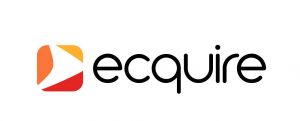 (photo 1)
(photo 1)
In order to create an account online, more and more private information needs to be filled out. Privacy information can be anything that identifies a person. For example, name, address, date of birth, phone number, marital status, and credit card information, those are all included but not limited to. Also, some social media websites like Facebook, What’s App, and Instagram, their users are able to see each others’ profiles. Luckily, in our British Columbia, The Freedom of Information and Protection of Privacy Act (FIPPA) commands that “no personally identifying information of British Columbians can be collected without their knowledge and consent, and that such information not be used for anything other than the purpose for which it was originally collected” (Klassen, 2011). However, users know that organizations and countries are sharing information, even servers in Canada still have risks to divulge private information.
Facebook had a serious security problem happened last year. Hackers controlled 50 million users’ accounts. Moreover, they used the information to check those users’ families and friends, then they got tons of information from one user to another. “Zuckerberg said, ‘Security is an arms race, and we’re continuing to improve our defenses. This just underscores there are constant attacks from people who are trying to underscore accounts in our community’” (Michelle, 2018). As the biggest social media application, Facebook even experienced this kind of awful incident. Governments also stepped into this problem, but they still cannot stop it. Have a think about other smaller organizations, their security systems are obviously weaker than Facebook’s. It’s easier for hackers to steal their users’ information. Moreover, some organizations collect users’ information and data for use in advertising and sale to third parties. “Both heavyweights Microsoft and Intel have been forced to turn off features which would have allowed either company to track its customers across the Internet. Mattel Interactive had to admit it embedded phone home software called “Broadcast” in its Reader Rabbit software” (Bob, 2019). It is impossible to prevent hacking problems from happening for now. However, we can try our best to share less information online.
The big question is how to make students’ to protect their privacy from online organizations?
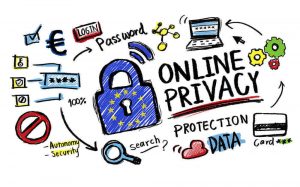 (photo 2)
(photo 2)
Firstly, privacy policies are always confusing and too wordy. Most people will not take a serious look at it. Online organizations should make their privacy policies be as concise as possible.
Secondly, schools should teach all students about the serious consequences of sharing data online. Because some students do not care about their privacy. Privacy is just like freedom, people will only take it seriously when they lose it. Also, schools need clearly communicating with students, parents, and teachers about privacy rights and policies.
Thirdly, students can reduce their use of online entertainment website. Be careful about entering banking information, address, and photos in public. Using Facebook as an example again, “It is for a bug the social network disclosed on Friday that may have affected up to 6.8 million people who used a Facebook login and gave permission to third-party apps to access their photos” (Esward, 2018). Although Facebook already fixed the bug, the access to those photos was broader than usual. AI technology nowadays can recognize individuals from even a blurry photo. With only a photo, all of your information can be searched online by strangers.
Fourthly, governments need to have a range of laws and regulations to protect privacy. Not only for students but also everyone in society. Although it may not prevent hackers from hacking websites, it may have a deterrent effect largely.
To sum up, everyone in society has a responsibility to protect their own private information. The main idea is to share less information online, read privacy policies carefully, and set up laws and regulations about protecting privacy. With the help of governments and educators, hope online privacy hacking problem can be solved one day.
References:
Ecquire. (2015). The World’s Greatest Privacy Policy – A 2018 update. Retrieved from http://ecquire.com/blog/privacy-policy/
Castillo, M. (2018). Facebook security breach allowed hackers to control the accounts of up to 50 million users. Retrieved from https://www.cnbc.com/2018/09/28/facebook-says-it-has-discovered-security-issue-affecting-nearly-50-million-accounts-investigation-in-early-stages.html
OBrien, A. (2014). A Starting Point for Ensuring Student Online Privacy. Retrieved from https://www.edutopia.org/blog/starting-point-ensuring-student-online-privacy-anne-obrien
Sullivan, B. (2019). Online privacy fears are real. Retrieved from http://www.nbcnews.com/id/3078835/t/online-privacy-fears-are-real/#.XU5BBehKiji
Baig, E. (2018). Facebook apologizes for bug that may have exposed photos of 6.8 million people. Retrieved from https://www.usatoday.com/story/tech/2018/12/14/facebook-photos-bug-may-have-impacted-6-8-million-people/2311617002/
Photo1 retrieved from https://venturebeat.com/2011/11/03/fast-pitch-nominees/
Photo 2 retrieved from https://www.bestvpndeals.com/protectyourprivacyonline
The original post is: https://csgo.opened.ca/#blog-post-2-our-online-information-are-all-in-control
Final Research Paper–Online Privacy Leakage
As education technologies increasingly use personal information and preferences to measure and assess student learning, online privacy deserves people’s attention. “The largest collection of breached data in history has been discovered, comprising more than 770m email addresses and passwords posted to a popular hacking forum in mid-December” (Hern, 2019). Nowadays, people cannot live without the internet. The internet brings numerous conveniences for life demands but also carries risks for online privacy. Only one click or one visit on the website can leave information for cyber marketing. Only one photo posted on the internet can live forever, although the user may have deleted it. There are some ideas that need to spread out and some actions people can take to protect their online privacy.
How did websites establish privacy policies about the use of data?
DuckDuckGo is a search engine that clearly points out the information they collected, not collected, and shared. “When you access DuckDuckGo or any Web site, your Web browser automatically sends information about your computer, e.g. your User agent and IP address. Because this information could be used to link you to your searches, we do not log (store) it at all. This is a very unusual practice, but we feel it is an important step to protect your privacy” (DuckDuckGo, 2012). For another example, Chegg is an online education website that I mostly used. After paying the monthly subscription, it provides the answers and online lessons to academic questions and assignments. Chegg clarifies its usage information as “the browser and operating system you are using, the URL or advertisement that referred you to our Services, the search terms you entered into a search engine that leads you to our Services, all of the areas within our Services that you visit, and the time of day you used the Services. Usage Information also includes information collected from interactive services, such as notes you take and engagement during study sessions, among other information” (Chegg, 2017). These two websites are good examples that clearly state the use of data. Some websites just use one or two sentences to skim over this part and make people confused. They also know that most people do have enough time and patience to read all the user agreements.

https://hackernoon.com/duckduckgo-vs-google-what-you-need-to-know-869368b08c4f
What is the consequence of disclosing personal information online?
In order to create an account online, more and more personal information needs to be filled out. Privacy information can be anything that identifies a person, including, but not limited to, name, address, date of birth, phone number, marital status, and credit card information. Also, some social media websites like Facebook, What’s App, and Instagram, their users are able to see each others’ profiles. Luckily, in our British Columbia, The Freedom of Information and Protection of Privacy Act (FIPPA) commands that “no personally identifying information of British Columbians can be collected without their knowledge and consent, and that such information not be used for anything other than the purpose for which it was originally collected” (Klassen, 2011). However, users know that organizations and countries are sharing information, even servers in Canada are still at risk of divulging private information.
Facebook had a serious security problem last year. Hackers controlled 50 million users’ accounts. Moreover, they used the information to check those users’ families and friends, then they got tons of information from one user to another. “Zuckerberg said, ‘Security is an arms race, and we’re continuing to improve our defenses. This just underscores there are constant attacks from people who are trying to underscore accounts in our community’” (Castillo, 2018). As the biggest social media application, Facebook even experienced this kind of awful incident. Governments also stepped into this problem, but they still cannot stop it. Consider other smaller organizations, their security systems are obviously weaker than Facebook’s. It’s easier for hackers to steal their users’ information.
People use Facebook as an application for entertainment, so it may make sense that they share information with each other and increase the risk of information leakage.
How about an educational website, which insists is purely for sharing knowledge purposes?

https://thejournal.com/articles/2017/05/12/millions-of-edmodo-user-accounts-for-sale-on-dark-web.aspx
Edmodo is a third party educational tool for the classroom. It creates an online community and coaching platform to K-12 schools and teachers. Each student has a profile on it, and teachers can assign the contents, quizzes, and assignments to learn on the system. Parents can also connect to the school and know what their children learn every day.
In 2017, Edmodo faced a serious security incident. A hacker “claims to have stolen more than 77 million user accounts from Edmodo, has put the data for sale on the Dark Web”(Ravipati, 2017). Edmodo has 78 million teachers, students, and parents in their system, which means almost every user’s information had been hacked and used for a business sale. Children have no prior credit, and they have very clean backgrounds, so their identity is much more valuable than an adult’s to criminals. Children’s information can be used to sign up for credit cards, obtaining loans or even mortgages. Nowadays, it is very common that some organizations collect users’ information and data for use in advertising and sale to third parties. “Both heavyweights Microsoft and Intel have been forced to turn off features which would have allowed either company to track its customers across the Internet. Mattel Interactive had to admit it embedded phone home software called “Broadcast” in its Reader Rabbit software” (Sullivan, 2019). It is impossible to prevent hacking problems from happening for now. However, we can try our best to share less information online.
The big question is how to encourage students to protect their privacy from online organizations?

https://www.bestvpndeals.com/protectyourprivacyonline
Firstly, privacy policies are always confusing and too wordy. Most people will not take a serious look at it. Online organizations should make their privacy policies be as concise as possible. If schools choose a specific educational application, schools need to take responsibility to go over the privacy policies and look up all information they can get to make sure it is safe for students to use.
Secondly, schools should teach all students about the serious consequences of sharing data online. Because some students do not care about their privacy. Privacy is just like freedom, people will only take it seriously when they lose it. Also, schools need to clearly communicate with students, parents, and teachers about privacy rights and policies.
Thirdly, students can reduce their use of online entertainment website. Be careful about entering banking information, address, and photos in public. Using Facebook as an example again, “It is for a bug the social network disclosed on Friday that may have affected up to 6.8 million people who used a Facebook login and gave permission to third-party apps to access their photos” (Baig, 2018). Although Facebook already fixed the bug, the access to those photos was broader than usual. AI technology nowadays can recognize individuals from even a blurry photo. With only a photo, all of your information can be searched online by strangers.
Fourthly, governments need to have a range of laws and regulations to protect privacy. Not only for students but also everyone in society. Although it may not prevent hackers from hacking websites, it may have a deterrent effect largely.
To sum up, everyone in society has a responsibility to protect their own private information. No one wants private information leakage happened again to Edmodo and other educational websites. It hurts children’s credits a lot. The main idea that needs to be spread out is to share less information online, read privacy policies carefully and set up laws and regulations about protecting privacy. And schools should not only consider their profits when they cooperate with an educational application, but also should consider students’ online safety. With the help of governments and educators, hope online privacy hacking problem can be solved one day.
Learning Pod Feedback:
The feedback I received from my learning pod was mainly about the examples I used in my article. We communicated through Wechat and share advice with each other. It is always good to get feedback from each other. They usually come up with new ideas that I never think about it before. They stand in a new perspective so they can point out some mistakes that I missed. I really appreciate everyone in my learning pod, as we communicate almost every day to discuss the assignments and exchange ideas. Although this is an online course, and we do not have a chance to meet with each other, they do give a feeling that we are all connected.
References:
Alex, H. (2019). Largest collection ever of breached data found. Retrieved from https://www.theguardian.com/technology/2019/jan/17/breached-data-largest-collection-ever-seen-email-password-hacking
Anne, O. (2014). A Starting Point for Ensuring Student Online Privacy. Retrieved from https://www.edutopia.org/blog/starting-point-ensuring-student-online-privacy-anne-obrien
Bob, S. (2019). Online privacy fears are real. Retrieved from http://www.nbcnews.com/id/3078835/t/online-privacy-fears-are-real/#.XU5BBehKiji
Chegg. (2017). Chegg.com US Privacy Policy. Retrieved from https://www.chegg.com/privacypolicy
Edward, B. (2018). Facebook apologizes for bug that may have exposed photos of 6.8 million people. Retrieved from https://www.usatoday.com/story/tech/2018/12/14/facebook-photos-bug-may-have-impacted-6-8-million-people/2311617002/
Gabriel, W. (2012). DuckDuckGo Privacy Policy. Retrieved from https://duckduckgo.com/privacy#s4
Michelle, C. (2018). Facebook security breach allowed hackers to control the accounts of up to 50 million users. Retrieved from https://www.cnbc.com/2018/09/28/facebook-says-it-has-discovered-security-issue-affecting-nearly-50-million-accounts-investigation-in-early-stages.html
Sri, R. (2017). Edmodo Investigates Millions of User Accounts for Sale on Dark Web. Retrieved from https://thejournal.com/articles/2017/05/12/millions-of-edmodo-user-accounts-for-sale-on-dark-web.aspx
Peers Feedback
We have four people in our groups, and we are using a Wechat group to communicate with each other.
My topic is about privacy information protection. They suggested me to use another educational website or application as an example, instead of using Facebook. Because the main purpose of this course is about online education, Facebook is not a main educational application. I’m going to find some new websites about online education and connect with online privacy.
They also help me with my grammar and APA format issue, which can make my research paper more professional.
Final Research Paper–Online Privacy Leakage
As education technologies increasingly use personal information and preferences to measure and assess student learning, online privacy deserves people’s attention. “The largest collection of breached data in history has been discovered, comprising more than 770m email addresses and passwords posted to a popular hacking forum in mid-December” (Hern, 2019). Nowadays, people cannot live without the internet. The internet brings numerous conveniences for life demands but also carries risks for online privacy. Only one click or one visit on the website can leave information for cyber marketing. Only one photo posted on the internet can live forever, although the user may have deleted it. There are some ideas that need to spread out and some actions people can take to protect their online privacy.
How did websites establish privacy policies about the use of data?
DuckDuckGo is a search engine that clearly points out the information they collected, not collected, and shared. “When you access DuckDuckGo or any Web site, your Web browser automatically sends information about your computer, e.g. your User agent and IP address. Because this information could be used to link you to your searches, we do not log (store) it at all. This is a very unusual practice, but we feel it is an important step to protect your privacy” (DuckDuckGo, 2012). For another example, Chegg is an online education website that I mostly used. After paying the monthly subscription, it provides the answers and online lessons to academic questions and assignments. Chegg clarifies its usage information as “the browser and operating system you are using, the URL or advertisement that referred you to our Services, the search terms you entered into a search engine that leads you to our Services, all of the areas within our Services that you visit, and the time of day you used the Services. Usage Information also includes information collected from interactive services, such as notes you take and engagement during study sessions, among other information” (Chegg, 2017). These two websites are good examples that clearly state the use of data. Some websites just use one or two sentences to skim over this part and make people confused. They also know that most people do have enough time and patience to read all the user agreements.

https://hackernoon.com/duckduckgo-vs-google-what-you-need-to-know-869368b08c4f
What is the consequence of disclosing personal information online?
In order to create an account online, more and more personal information needs to be filled out. Privacy information can be anything that identifies a person, including, but not limited to, name, address, date of birth, phone number, marital status, and credit card information. Also, some social media websites like Facebook, What’s App, and Instagram, their users are able to see each others’ profiles. Luckily, in our British Columbia, The Freedom of Information and Protection of Privacy Act (FIPPA) commands that “no personally identifying information of British Columbians can be collected without their knowledge and consent, and that such information not be used for anything other than the purpose for which it was originally collected” (Klassen, 2011). However, users know that organizations and countries are sharing information, even servers in Canada are still at risk of divulging private information.
Facebook had a serious security problem last year. Hackers controlled 50 million users’ accounts. Moreover, they used the information to check those users’ families and friends, then they got tons of information from one user to another. “Zuckerberg said, ‘Security is an arms race, and we’re continuing to improve our defenses. This just underscores there are constant attacks from people who are trying to underscore accounts in our community’” (Castillo, 2018). As the biggest social media application, Facebook even experienced this kind of awful incident. Governments also stepped into this problem, but they still cannot stop it. Consider other smaller organizations, their security systems are obviously weaker than Facebook’s. It’s easier for hackers to steal their users’ information.
People use Facebook as an application for entertainment, so it may make sense that they share information with each other and increase the risk of information leakage.
How about an educational website, which insists is purely for sharing knowledge purposes?

https://thejournal.com/articles/2017/05/12/millions-of-edmodo-user-accounts-for-sale-on-dark-web.aspx
Edmodo is a third party educational tool for the classroom. It creates an online community and coaching platform to K-12 schools and teachers. Each student has a profile on it, and teachers can assign the contents, quizzes, and assignments to learn on the system. Parents can also connect to the school and know what their children learn every day.
In 2017, Edmodo faced a serious security incident. A hacker “claims to have stolen more than 77 million user accounts from Edmodo, has put the data for sale on the Dark Web”(Ravipati, 2017). Edmodo has 78 million teachers, students, and parents in their system, which means almost every user’s information had been hacked and used for a business sale. Children have no prior credit, and they have very clean backgrounds, so their identity is much more valuable than an adult’s to criminals. Children’s information can be used to sign up for credit cards, obtaining loans or even mortgages. Nowadays, it is very common that some organizations collect users’ information and data for use in advertising and sale to third parties. “Both heavyweights Microsoft and Intel have been forced to turn off features which would have allowed either company to track its customers across the Internet. Mattel Interactive had to admit it embedded phone home software called “Broadcast” in its Reader Rabbit software” (Sullivan, 2019). It is impossible to prevent hacking problems from happening for now. However, we can try our best to share less information online.
The big question is how to encourage students to protect their privacy from online organizations?

https://www.bestvpndeals.com/protectyourprivacyonline
Firstly, privacy policies are always confusing and too wordy. Most people will not take a serious look at it. Online organizations should make their privacy policies be as concise as possible. If schools choose a specific educational application, schools need to take responsibility to go over the privacy policies and look up all information they can get to make sure it is safe for students to use.
Secondly, schools should teach all students about the serious consequences of sharing data online. Because some students do not care about their privacy. Privacy is just like freedom, people will only take it seriously when they lose it. Also, schools need to clearly communicate with students, parents, and teachers about privacy rights and policies.
Thirdly, students can reduce their use of online entertainment website. Be careful about entering banking information, address, and photos in public. Using Facebook as an example again, “It is for a bug the social network disclosed on Friday that may have affected up to 6.8 million people who used a Facebook login and gave permission to third-party apps to access their photos” (Baig, 2018). Although Facebook already fixed the bug, the access to those photos was broader than usual. AI technology nowadays can recognize individuals from even a blurry photo. With only a photo, all of your information can be searched online by strangers.
Fourthly, governments need to have a range of laws and regulations to protect privacy. Not only for students but also everyone in society. Although it may not prevent hackers from hacking websites, it may have a deterrent effect largely.
To sum up, everyone in society has a responsibility to protect their own private information. No one wants private information leakage happened again to Edmodo and other educational websites. It hurts children’s credits a lot. The main idea that needs to be spread out is to share less information online, read privacy policies carefully and set up laws and regulations about protecting privacy. And schools should not only consider their profits when they cooperate with an educational application, but also should consider students’ online safety. With the help of governments and educators, hope online privacy hacking problem can be solved one day.
Learning Pod Feedback:
The feedback I received from my learning pod was mainly about the examples I used in my article. We communicated through Wechat and share advice with each other. It is always good to get feedback from each other. They usually come up with new ideas that I never think about it before. They stand in a new perspective so they can point out some mistakes that I missed. I really appreciate everyone in my learning pod, as we communicate almost every day to discuss the assignments and exchange ideas. Although this is an online course, and we do not have a chance to meet with each other, they do give a feeling that we are all connected.
References:
Alex, H. (2019). Largest collection ever of breached data found. Retrieved from https://www.theguardian.com/technology/2019/jan/17/breached-data-largest-collection-ever-seen-email-password-hacking
Anne, O. (2014). A Starting Point for Ensuring Student Online Privacy. Retrieved from https://www.edutopia.org/blog/starting-point-ensuring-student-online-privacy-anne-obrien
Bob, S. (2019). Online privacy fears are real. Retrieved from http://www.nbcnews.com/id/3078835/t/online-privacy-fears-are-real/#.XU5BBehKiji
Chegg. (2017). Chegg.com US Privacy Policy. Retrieved from https://www.chegg.com/privacypolicy
Edward, B. (2018). Facebook apologizes for bug that may have exposed photos of 6.8 million people. Retrieved from https://www.usatoday.com/story/tech/2018/12/14/facebook-photos-bug-may-have-impacted-6-8-million-people/2311617002/
Gabriel, W. (2012). DuckDuckGo Privacy Policy. Retrieved from https://duckduckgo.com/privacy#s4
Michelle, C. (2018). Facebook security breach allowed hackers to control the accounts of up to 50 million users. Retrieved from https://www.cnbc.com/2018/09/28/facebook-says-it-has-discovered-security-issue-affecting-nearly-50-million-accounts-investigation-in-early-stages.html
Sri, R. (2017). Edmodo Investigates Millions of User Accounts for Sale on Dark Web. Retrieved from https://thejournal.com/articles/2017/05/12/millions-of-edmodo-user-accounts-for-sale-on-dark-web.aspx









 (photo 1)
(photo 1) (photo 2)
(photo 2)
